

User stories: Why is it Important to Agile? - Agile Scrum. What I like about Agile the most is its use of the User Story to determine requirements and add a very human factor to the software development project.
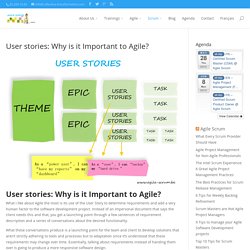
Instead of an impersonal document that says the client needs this and that, you get a launching point through a few sentences of requirement description and a series of conversations about the desired functionality. What these conversations produce is a launching point for the team and client to develop solutions that aren’t strictly adhering to tools and processes but to adaptation since it’s understood that these requirements may change over time. Essentially, talking about requirements instead of handing them over is going to produce a more responsive software design. According to Mountain Goat Software, User stories are short, simple description of a feature told from the perspective of the person who desires the new capability, usually a user or customer of the system. According to Mountain Goat Software, 8 useful strategies for splitting large user stories (and a cheatsheet) I recently coached a team that ran into problems because the user stories in their sprint turned out to be too big.
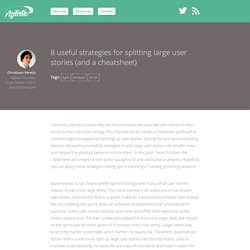
This inspired me to create a cheatsheet (pdf) with 8 common Agile strategies for splitting up user stories. During the next sprint planning session, the team successfully managed to split large user stories into smaller ones and helped the product owner prioritize them. In this post, I want to share the cheatsheet and extend it with some background and additional examples. Hopefully, you can apply these strategies during sprint planning or backlog grooming sessions. Experienced Scrum Teams prefer sprint backlogs with many small user stories instead of just a few large items. Horizontal versus vertical splitting? Broadly speaking, there are two approaches for breaking up large user stories. Individual items do not deliver business value: Suppose that a team works on an order process for a webshop in a sprint.
The Easy Way to Writing Good User Stories. Many development shops have opted to writing user stories over traditional feature/requirement documents; however, almost all of them struggle when writing their first batch of user stories.
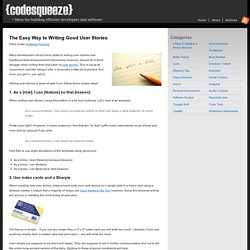
This is not at all uncommon, just like riding a bike, it does take a little bit of practice (but once you get it – you get it). Writing user stories is dead simple if you follow these simple steps: 1. Connecting the Dots Between Analysis and Design. Most software teams seem to lump together the terms Analysis and Design into one pre-development phase.
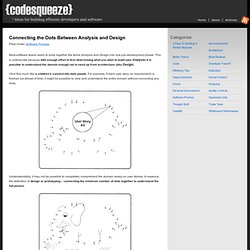
This is unfortunate because with enough effort in first determining what you wish to build (aka Analysis) it is possible to understand the domain enough not to need up front architecture (aka Design). I find this much like a children’s connect-the-dots puzzle. For example, if each user story (or requirement) is flushed out ahead of time, it might be possible to view and understand the entire domain without connecting any lines. Understandably, it may not be possible to completely comprehend the domain solely on user stories. In essence, the definition of design or prototyping – connecting the minimum number of dots together to understand the full picture. Determining what needs to be built is the hardest part of development. This process, while simple, still takes a lot of maturity to accomplish. Do not fall prey to Analysis Paralysis; sometimes good enough has to be good enough.
Features vs. user stories in Scrum. 2 Days hands-on Training/Workshop on Agile Testing by Naresh Jain - Expert Agile, Scrum, eXtreme Programming and Lean Startup Trainer and Coach in India. Over the past decade, eXtreme Programming practices like User Stories, Test-Driven Development (TDD), Behaviour Driven Developer (BDD), Refactoring, Continuous Integration, Exploratory Testing and Automation have fundamentally changed how testers work.
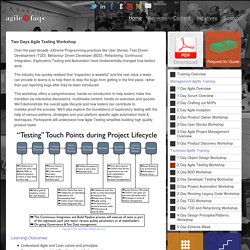
The industry has quickly realised that “inspection is wasteful” and the real value a tester can provide to teams is to help them to stop the bugs from getting in the first place, rather than just reporting bugs after they've been introduced. This workshop offers a comprehensive, hands-on introduction to help testers make this transition via interactive discussions, multimedia content, hands-on exercises and quizzes. We'll demonstrate the overall agile lifecycle and how testers can contribute to mistake-proof the process. We'll also explore the foundations of exploratory testing with the help of various patterns, strategies and your platform specific agile automation tools & techniques. Learning Outcomes Course Outline Method of Instruction. Backlog Grooming: Who Should Attend and How to Maximize Value. Grooming Archives - Roman Pichler.
Grooming the product backlog means managing the backlog.

This is necessary, as the product backlog changes and evolves: The team gains knowledge from exposing a product increment to the users, and the latest insights lead to a backlog update, as the picture below shows. The new user story backlog is a map. Why the flat user story backlog doesn’t work, and how to build a better backlog that will help you more effectively explain your system, prioritize, and plan your releases.

This is Gary. User Story Mapping in Practice. How to Create your Initial Product Canvas. The Product Canvas is a simple, yet powerful tool that helps you create a product with a great user experience and the right features.
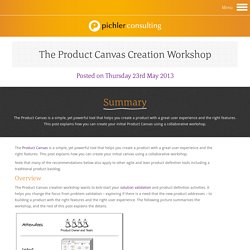
This post explains how you can create your initial canvas using a collaborative workshop. Lean Requirements with User Acceptance Test Cases. The Agile Manifesto extols the virtues of working software over documentation as a true measure of progress and business value.

Teams in the early stages of agile adoption sometimes misinterpret this to mean that they should not write anything down. Other teams that are accustomed to waterfall and documentation-heavy methodologies continue creating extensive and redundant documentation under the guise of User Stories and Acceptance Criteria. Lean Agile Requirements is a middle ground that provides a framework in which complex requirements are captured in living documents that speak to many audiences and serve a purpose beyond the initial development of the application. The flow for discovering and capturing these requirements in the process of developing new software appears in the diagram below. 10 Tips for Writing Good User Stories. 1 Users Come First As its name suggests, a user story describes how a customer or user employs the product; it is written from the user’s perspective.
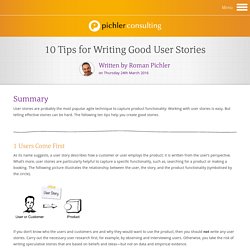
What’s more, user stories are particularly helpful to capture a specific functionality, such as, searching for a product or making a booking. The following picture illustrates the relationship between the user, the story, and the product functionality (symbolised by the circle). 2 Days hands-on Training/Workshop on Agile User Stories by Naresh Jain - Expert Agile, Scrum, eXtreme Programming and Lean Startup Trainer and Coach in India. The User Story Workshop offers a comprehensive, hands-on introduction to authoring high quality user stories combining techniques from eXtreme Programming and User Centred Design (CDP). User Stories helps us manage requirements. Their primary job is to define the value a user gains from the system. Since User Stories focus on the underlying Agile values of collaboration and Just-In-Time definition, it makes them a good Agile tool. INVEST in Good Stories, and SMART Tasks.
(French) In XP, we think of requirements of coming in the form of user stories. It would be easy to mistake the story card for the “whole story,” but Ron Jeffries points out that stories in XP have three components: Cards (their physical medium), Conversation (the discussion surrounding them), and Confirmation (tests that verify them). A pidgin language is a simplified language, usually used for trade, that allows people who can’t communicate in their native language to nonetheless work together. User stories act like this. We don’t expect customers or users to view the system the same way that programmers do; stories act as a pidgin language where both sides can agree enough to work together effectively. But what are characteristics of a good story? I – IndependentN – NegotiableV – ValuableE – EstimableS – SmallT – Testable Independent Stories are easiest to work with if they are independent.
Free Friday Agile workshops at Boost - Scrum and User Stories. [Here’s the tl;dr version of this blog post. Every Friday we run free workshops about Agile development here at the Boost offices in Wellington. To find out more, read on. To sign up, scroll down to the end of this post, or email info@boost.co.nz] We keep meeting more and more people curious about how using Agile might help their organisations. So a few months ago we sat down and developed a two-hour workshop, Introduction to Scrum, which introduces the main Agile ideas and practices, with a special focus on the Scrum techniques that we use. Agile and user story workshop Peter Saddington. INVEST (mnemonic) One of the characteristics of Agile Methodologies such as Scrum or XP is the ability to move stories around, taking into account their relative priority - for example - without much effort. If you find user stories that are tightly dependent, a good idea might be to combine them into a single user story.
The only thing that is fixed and set in stone in an agile project is an iteration backlog (and, even then, it can be broken). While the story lies in the product backlog, it can be rewritten or even discarded, depending on business, market, technical or any other type of requirement by team members. Six attributes of good user stories. One of the things that many agilists struggle with, particularly in the beginning, is what constitutes a “good” story. Many people start out with the familiar agile format of “as a user, I want to do this, for that reason,” but quickly find themselves running into issues of finding the right story size, complexity, scope, and various other factors. Fortunately, experience has provided a good framework for managing these issues. Six Features of a Good User Story - INVEST Model. 5 Common User Story Mistakes by Roman Pichler.
5 Common Mistakes We Make Writing User Stories - Scrum Alliance. 3 Mistakes to Avoid When Writing User Stories (with Examples) So you want to build an app.